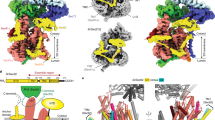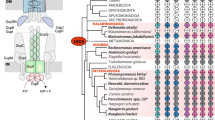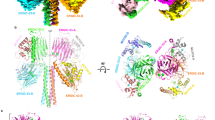Abstract
The exocyst is a conserved protein complex essential for trafficking secretory vesicles to the plasma membrane. The structure of the C-terminal domain of the exocyst subunit Sec6p reveals multiple helical bundles, which are structurally and topologically similar to Exo70p and the C-terminal domains of Exo84p and Sec15, despite <10% sequence identity. The helical bundles appear to be evolutionarily related molecular scaffolds that have diverged to create functionally distinct exocyst proteins.
This is a preview of subscription content, access via your institution
Access options
Subscribe to this journal
Receive 12 print issues and online access
$189.00 per year
only $15.75 per issue
Buy this article
- Purchase on Springer Link
- Instant access to full article PDF
Prices may be subject to local taxes which are calculated during checkout


Similar content being viewed by others
References
Bonifacino, J.S. & Glick, B.S. Cell 116, 153–166 (2004).
TerBush, D.R., Maurice, T., Roth, D. & Novick, P. EMBO J. 15, 6483–6494 (1996).
Hsu, S.C. et al. Neuron 17, 1209–1219 (1996).
Sivaram, M.V., Saporita, J.A., Furgason, M.L., Boettcher, A.J. & Munson, M. Biochemistry 44, 6302–6311 (2005).
Guo, W., Roth, D., Walch-Solimena, C. & Novick, P. EMBO J. 18, 1071–1080 (1999).
Vega, I.E. & Hsu, S.C. J. Neurosci. 21, 3839–3848 (2001).
Matern, H.T., Yeaman, C., Nelson, W.J. & Scheller, R.H. Proc Natl. Acad. Sci. USA 98, 9648–9653 (2001).
Dong, G., Hutagalung, A.H., Fu, C., Novick, P. & Reinisch, K.M. Nat. Struct. Mol. Biol. 12, 1094–1100 (2005).
Lamping, E. et al. Gene 361, 57–66 (2005).
Novick, P., Field, C. & Schekman, R. Cell 21, 205–215 (1980).
Wu, S., Mehta, S.Q., Pichaud, F., Bellen, H.J. & Quiocho, F.A. Nat. Struct. Mol. Biol. 12, 879–885 (2005).
Hamburger, Z.A., Hamburger, A.E., West, A.P. & Weis, W.I. J. Mol. Biol. 356, 9–21 (2006).
Hsu, S.C. et al. Neuron 20, 1111–1122 (1998).
Whyte, J.R. & Munro, S. J. Cell Sci. 115, 2627–2637 (2002).
Acknowledgements
We are grateful to S. Ryder, W. Royer, W. Kobertz and R. Gilmore for critical reading of this manuscript and discussions. Thanks to the staff at the X25 and X29 beamlines at the National Synchrotron Light Source and to D. Lambright, B. van den Berg, S. Eathiraj and members of the Lambright laboratory for help with structure determination. This work was supported by US National Institutes of Health grant GM068803 to M.M. and an American Heart Association award to M.V.S.S.
Author information
Authors and Affiliations
Corresponding author
Ethics declarations
Competing interests
The authors declare no competing financial interests.
Supplementary information
Supplementary Fig. 1
The C-terminal domain of Sec6p is essential and binds Exo70p and Sec10p (PDF 2246 kb)
Supplementary Fig. 2
Final model and electron density map (PDF 1866 kb)
Supplementary Fig. 3
Packing of Sec6CT2 in the crystal (PDF 1100 kb)
Supplementary Fig. 4
Structure-based sequence alignment of Sec6CT2 (PDF 415 kb)
Supplementary Fig. 5
Sec6CT2, Exo70p, Exo84CT and Sec15CT have distinct surface features (PDF 2657 kb)
Supplementary Fig. 6
Secondary structure prediction profiles (PDF 29 kb)
Supplementary Table 1
Data collection and refinement statistics (PDF 96 kb)
Rights and permissions
About this article
Cite this article
Sivaram, M., Furgason, M., Brewer, D. et al. The structure of the exocyst subunit Sec6p defines a conserved architecture with diverse roles. Nat Struct Mol Biol 13, 555–556 (2006). https://doi.org/10.1038/nsmb1096
Received:
Accepted:
Published:
Issue Date:
DOI: https://doi.org/10.1038/nsmb1096
This article is cited by
-
Crystal structure of Sec10, a subunit of the exocyst complex
Scientific Reports (2017)
-
Subunit connectivity, assembly determinants and architecture of the yeast exocyst complex
Nature Structural & Molecular Biology (2016)
-
Distinct Roles for the N- and C-terminal Regions of M-Sec in Plasma Membrane Deformation during Tunneling Nanotube Formation
Scientific Reports (2016)
-
Syntaxin opening by the MUN domain underlies the function of Munc13 in synaptic-vesicle priming
Nature Structural & Molecular Biology (2015)
-
The exocyst complex in exocytosis and cell migration
Protoplasma (2012)



